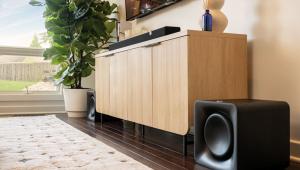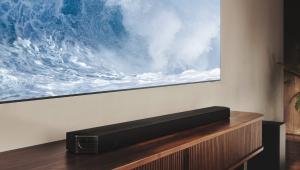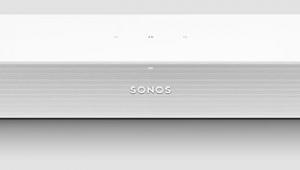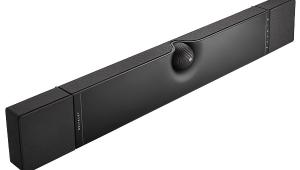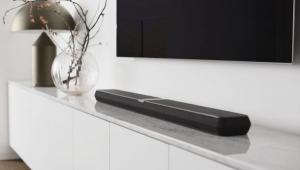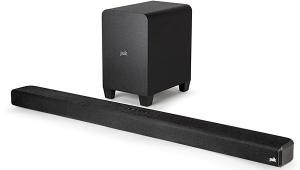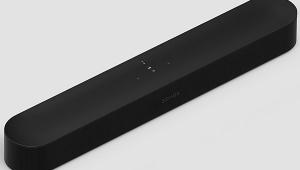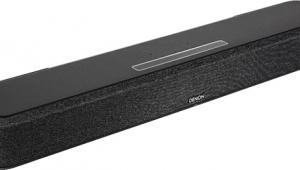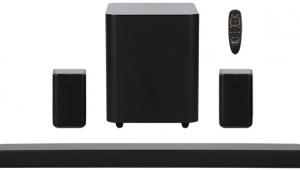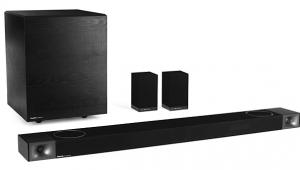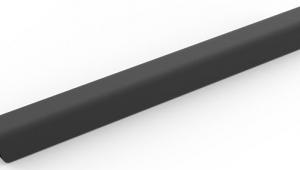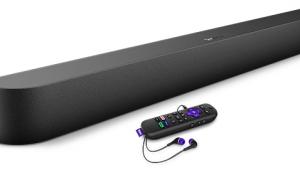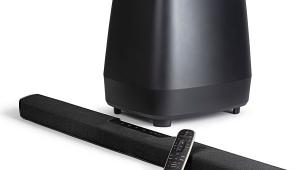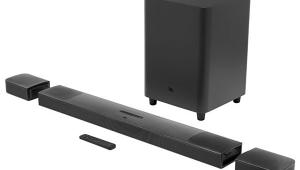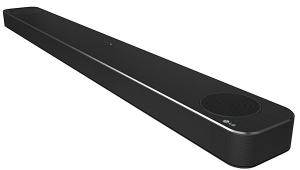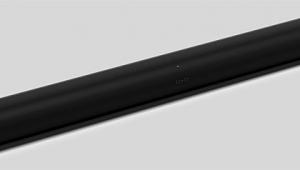This soundbar downgrades DTS to 2.0, a major con. This is a surprising omission in this review.
Samsung HW-K950 Soundbar System Review

AT A GLANCE
Plus
Full surround, including Dolby Atmos, from just four boxes
Rich, punchy sound
Minus
Limited connectivity
Pricey for a soundbar
THE VERDICT
A soundbar with Dolby Atmos may seem like an oxymoron, but Samsung has done a masterful job of pulling it off. The HW-K950 delivers a hefty slice of the performance you can get from a carefully tuned component system, but without most of the complexity or a room full of speakers.
Sometimes it seems like the people who develop new surround formats are completely out of touch with what real consumers actually want in their homes. Over the years, we have seen a seemingly endless parade of multichannel surround formats, such as Dolby Digital Surround EX, Dolby Pro Logic IIz, DTS-HD Master Audio, Audyssey DSX, and now Dolby Atmos—all guaranteed to strain your domestically acceptable loudspeaker limit. It’s no wonder that so many folks have decided to just pull out of this arms race and go instead with a simple soundbar. The good news: It appears that someone at Samsung is paying attention. The company’s latest top-of-the-range soundbar-based system tries to let you have it all, combining the compactness and simplicity of a soundbar with the tangible spatial effects that only really happen when you have discrete rear speakers and the vertical expansiveness of Dolby Atmos.
The HW-K950 system comprises a total of four separate speakers, but within those four boxes lurk nine individual speaker channels plus a subwoofer. To make things even simpler, Samsung has eliminated most of the typical wires by making those four boxes speak to each other wirelessly.
The soundbar itself houses five of the channels, using 11 drivers. The left, center, and right channels are spread across the full width of the front face of the soundbar, with each channel using a soft-dome tweeter and a pair of small paper-cone woofers. The left and right channels position the tweeter at the outer edge to maximize the soundstage width. Rounding out the soundbar is a pair of full-range, upward-firing drivers, aimed slightly forward so higher frequencies reflect off the ceiling then down toward the listening area. These deliver the front height channels for Atmos.
The two wireless rear speakers are simpler in approach, each using a single full-range, forward-facing driver for its surround channel and another identical driver firing upward and slightly forward for its rear height channel. Lastly, there’s the wireless subwoofer, which uses a direct-radiating 8-inch driver and a big, flared, rear-facing port to pump out the deep bass.
As with any so-called wireless system, you still need to make a few hookups to deliver the power for the built-in amplifiers and wireless receiver in each speaker, as well as to get signals from your sources and to your TV set. That said, Samsung has managed to avoid using those clunky wall-wart power supplies for the surround speakers and subwoofer—which leaves just one rather discreet brick for the soundbar. One interesting detail I noticed in the specs is that the system has 16 individual amp channels, one for each and every driver. This presumably gave the Samsung engineers who voiced the system more control over the dynamic processing, so they could extract the maximum output from what really are rather small drivers.
 Some of Samsung’s previous soundbars have been a bit disappointing in the fit-and-finish department, with lightweight shiny-black-plastic construction and less than reassuring solidity. But as you’d expect from the HW-K950, given its premium price, this soundbar looks and feels much more substantial, even though it still seems to be made from some kind of plastic. To give it a more sophisticated and high-tech appearance, Samsung has wrapped the top, front, and rear surfaces with a black mesh metal grille. A white LED display peeks through the grille to indicate the various functions and is easy to read from across the room. Each end of the soundbar has a brushed-metal finish plate, and there are a few simple controls set into the plate on the right side. That’s a helpful feature when the remote gets lost in the depths of your sofa cushions. The overall look is more businesslike than glitzy, with a styling that complements most contemporary TV sets. The surround speakers continue the tech theme, with perforated black metal grilles covering the top and front, and brushed metal panels on the sides.
Some of Samsung’s previous soundbars have been a bit disappointing in the fit-and-finish department, with lightweight shiny-black-plastic construction and less than reassuring solidity. But as you’d expect from the HW-K950, given its premium price, this soundbar looks and feels much more substantial, even though it still seems to be made from some kind of plastic. To give it a more sophisticated and high-tech appearance, Samsung has wrapped the top, front, and rear surfaces with a black mesh metal grille. A white LED display peeks through the grille to indicate the various functions and is easy to read from across the room. Each end of the soundbar has a brushed-metal finish plate, and there are a few simple controls set into the plate on the right side. That’s a helpful feature when the remote gets lost in the depths of your sofa cushions. The overall look is more businesslike than glitzy, with a styling that complements most contemporary TV sets. The surround speakers continue the tech theme, with perforated black metal grilles covering the top and front, and brushed metal panels on the sides.
At its most fundamental, a soundbar system like this can provide relief from the puny speakers crammed into most TVs these days—but for many owners, it will also serve as their primary music system. Wired connectivity is pretty basic, with just two HDMI inputs, an optical digital input, and a 3.5mm analog jack, but you can also stream wirelessly to the system. A Bluetooth connection lets you play music directly from your phone or tablet, while a Wi-Fi connection lets you integrate the soundbar into your home network using Samsung’s Multiroom App. That’s handy if you have a bunch
of other Samsung audio products around the house, but it lacks the multi-brand functionality of something like DTS Play-Fi or Apple AirPlay. The Samsung app is rather decent and includes popular streaming services like Pandora, Spotify, SiriusXM, Rhapsody, and Tidal, along with radio apps like iHeartRadio and TuneIn.
Setup
At around 48 inches wide, the soundbar fits nicely with most 50-to-55-inch TVs, but there’s nothing to stop you from using it with something larger. Wall-mounting brackets are included, but with the top-mounted Atmos speakers aimed up toward the ceiling, you’ll want to make sure your TV won’t block the sound path. I put the soundbar on a table right under my TV and about a foot away from the front wall, to give everything plenty of clearance. The subwoofer was on the floor to the left of the table, leaving enough space for its rear-firing port to breathe a bit. The surround speakers were against the side walls and slightly behind the listening position, with a clear path up to my flat 9-foot ceiling.
To use the Dolby Atmos function, you need to connect your Blu-ray player using HDMI, so I did that, and I added my cable box to the second HDMI input. While two HDMI inputs may seem a bit limiting for some users, the HDMI output for the TV does include the Audio Return Channel (ARC) feature, so you can always use your TV as a source switcher.
- Log in or register to post comments


